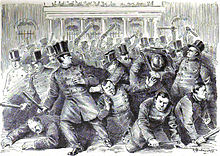New York City Police Riot
| New York City Police riot of 1857 | |||||||
|---|---|---|---|---|---|---|---|
| Part of History of New York City (1855–1897) | |||||||
 Municipal and Metropolitan police fight in front of New York City Hall. |
|||||||
|
|||||||
| Casualties and losses | |||||||
| 53 injured | |||||||
The New York City Police riot of 1857, known at the time as the Great Police riot, was a conflict which occurred between the recently dissolved New York Municipal Police and the newly formed Metropolitan Police on June 16, 1857. Arising over Mayor Fernando Wood's appointment of Charles Devlin over Daniel Conover for the position of city street commissioner, amid rumors that Devlin purchased the office for $50,000 from Wood himself, Municipal police battled Metropolitan officers attempting to arrest Mayor Wood.
Two arrest warrants had been issued against the Mayor following an altercation between him and Conover when arriving at City Hall to assume his office. The situation was resolved only with the intervention of the New York State Militia under Major General Charles W. Sandford.
Massive police corruption, under Mayor Fernando Wood, prompted the New York state legislature to relieve him of control over the city's police. Several related bills were passed during the spring of 1857; the most important of these abolished the Municipal Police and Police Board that had been formed under an act of 1853. The bill replaced them with a Metropolitan Police District that would fall under the jurisdiction of Manhattan, Brooklyn, Staten Island and the other boroughs of present-day New York City. This new police force was to be controlled by five commissioners appointed by the Governor of New York: Simeon Draper, James Bowen, James W. Nye, Jacob Cholwell and James S.T. Stranahan. The head of the commission was Frederick Augustus Tallmadge, noted reformer and Recorder of New York City during the Astor Place Riots of 1849, who accepted the position of Superintendent of Police after several others had declined.
...
Wikipedia
